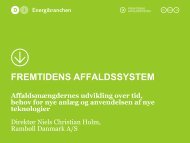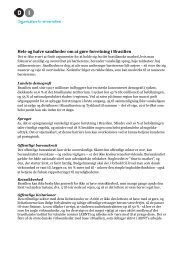Turning waste into climate-friendly energy
Turning waste into climate-friendly energy
Turning waste into climate-friendly energy
Create successful ePaper yourself
Turn your PDF publications into a flip-book with our unique Google optimized e-Paper software.
THE DANISH ENERGY INDUSTRIES FEDERATION – SpEcIAl ADvERTISING SUpplEmENT<br />
60 percent of household heating<br />
in Denmark is generated<br />
from <strong>energy</strong>-efficient district<br />
heating plants. If this technology<br />
were introduced globally,<br />
CO2 emissions would be significantly<br />
reduced.<br />
By: Maren Urban Swart<br />
The demand for <strong>energy</strong> is increasing<br />
globally in line with the inexorable<br />
rise in global population. In order to<br />
avoid adverse effects on the Earth’s<br />
<strong>climate</strong>, it is essential that <strong>energy</strong> efficiency<br />
is improved. One example<br />
of this is Denmark’s unique achievements<br />
in district heating.<br />
”We have achieved this position because<br />
we do not use resources to cool<br />
down the hot water that is created in<br />
“District heating has great potential, and is supported<br />
by EU plans to ensure that <strong>waste</strong> heat from electricity<br />
production is recovered and utilised,” says Rambøll <strong>energy</strong><br />
director Thomas Rand.<br />
Climate <strong>friendly</strong> heating and cooling<br />
electricity production, but instead channel<br />
it <strong>into</strong> the district heating system,”<br />
says COO Kim Fausing of Danish industrial<br />
company Danfoss.<br />
Only nine percent of the heat generated<br />
globally in electricity production is<br />
utilised. If this figure was increased to<br />
12 percent, it would equate to the <strong>energy</strong><br />
generated by all the wind turbines in the<br />
world. This statistic helps explain why<br />
many countries worldwide are now looking<br />
towards Denmark and its competences<br />
in district heating. ”We are establishing<br />
new systems and are improving<br />
the efficiency of already existing systems<br />
worldwide,” says Kim Fausing.<br />
KEEpING cOOl<br />
Danish engineering and consultancy<br />
company Rambøll has also noted the<br />
international interest. ”We see it in<br />
FAcTs:<br />
District heating is a system<br />
for distributing heat<br />
generated in a centralised<br />
location for residential<br />
and commercial<br />
space- and water-heating<br />
requirements.<br />
the UK for example, which is establishing<br />
an increasing number of isolated<br />
district heating systems due to<br />
sustainability requirements when new<br />
urban districts are built,” says Thomas<br />
Rand, <strong>energy</strong> director at Rambøll.<br />
Rambøll’s system can provide both<br />
district heating and district cooling in<br />
a more <strong>energy</strong>-efficient way. ”We see<br />
a need for this not only internationally,<br />
but also in Denmark, where there<br />
has not previously been a demand for<br />
district cooling. The demand has occurred<br />
because of an increased focus<br />
on comfort in for example office buildings,<br />
where computers are creating a<br />
warm indoor <strong>climate</strong>,” says Thomas<br />
Rand. The <strong>energy</strong> efficiency of district<br />
cooling is five to ten times higher than<br />
air conditioning systems. ·





